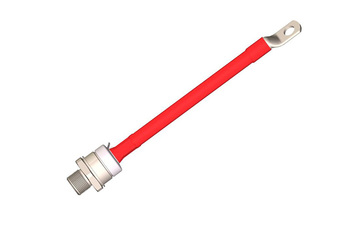Diodes
Diode DA171-320X
Diodes
| VRRM [V min]: | 400 |
| VRRM [V max]: | 1800 |
| IFAV [A]: | 320 |
| Tс: | 119 |
| VFM (Tc=25°С) [V]: | 1.40 |
| IFM (Tc=25°С) [A]: | 1005 |
| VF(TO)/Tjmax [V]: | 0.853 |
| rT/Tjmax [mΩ]: | 0.524 |
| Tjmax [°С]: | 150 |
| Rthjc [°С/W]: | 0.075 |
| Package: | D.SB1 |
| Design: | stud |
| Type: | avalanche |
- Documents and certificates
- Datasheet Diode DA171-320X
- Application Note Open PDF
- Description
DA171-320X is an avalanche reverse polarity (X) diode in stud design. It has a repetitive peak reverse voltage VRRM of 400-1800 V and low static losses. Mean forward current IFAV is 320А. Industry standard design enables easy installation into existing equipment. Maximal junction temperature Tjmax is 150 °C.
Avalanche diodes are designed for general application in systems up to 500 Hz. Anode and cathode are flat bases. Polarity of the diode is marked by a polarity symbol on its housing. Operation principle of avalanche diodes is based on the effect of reversible breakdown of the p-n junction under reverse voltage. As soon as the voltage reaches certain value set by design each avalanche diode, current sharply rises while voltage remains the same. Main role of avalanche diodes is protection of power circuits from overvoltages.
Avalanche diodes by Proton-Electrotex have the following features:
∙ high resistance to electric and thermal cycling;
∙ low dynamic losses;
∙ high reliability means minimal equipment downtime;
∙ optimized for industrial use.
At the customer's request Proton-Electrotex is able to select the optimal power diode for given operation modes. It is also possible to ship ready-to-use power semiconductors in assembly with heatsinks.To buy the DA171-320X diode, request a quotation or a technical advice, please contact the sales department by phone +7 4862 440456 or email marketing@proton-electrotex.com.
- Applications
Avalanche diodes are designed for static converters and other AC/DC circuits operating on standard or increased frequency requiring low reverse recovery time and high surge reverse power dissipation.
















